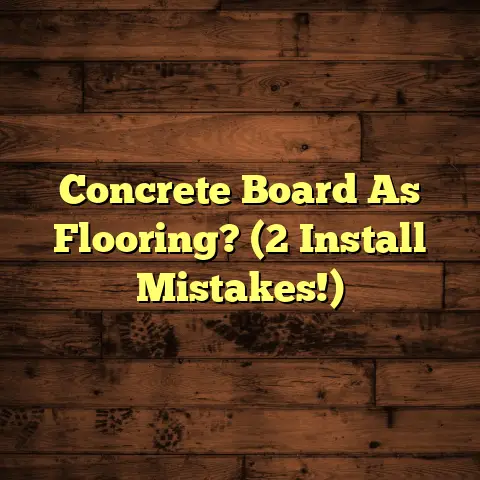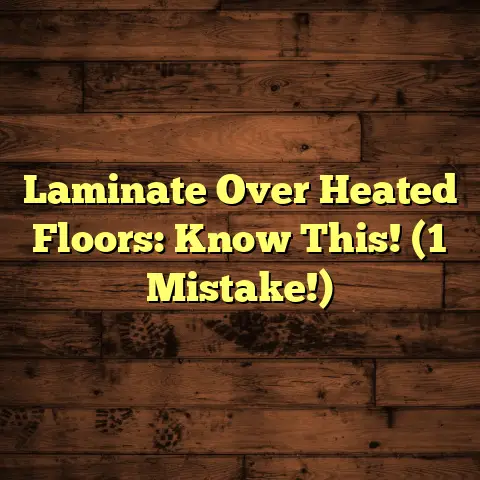Bamboo Flooring Durability: Read This Now! (1 Mistake!)
Ever dreamt of stepping into your home, sunlight dancing on your beautiful bamboo floors?
I know I have!
Imagine that warm, natural vibe, the unique grain patterns telling a story.
But what if, just months later, scratches and dents appear?
What if the eco-friendly flooring you loved starts showing wear and tear way too soon?
This is a real concern, and it begs the question: Is bamboo flooring really as durable as we’re led to believe?
Let’s dive in and find out!
1. Understanding Bamboo Flooring
1.1 What is Bamboo Flooring?
So, what is bamboo flooring, exactly?
Well, bamboo isn’t actually wood; it’s a grass! Crazy, right?
But it’s an incredibly strong, fast-growing grass.
To make flooring, bamboo stalks are harvested, sliced into strips, and then processed.
These strips are then either glued together horizontally (horizontal bamboo), vertically (vertical bamboo), or woven together under high pressure (strand-woven bamboo).
- Horizontal Bamboo: Shows the distinct “knuckle” pattern of the bamboo.
It’s generally softer than strand-woven. - Vertical Bamboo: Has a more uniform, linear appearance.
Slightly harder than horizontal but still not as durable as strand-woven. - Strand-Woven Bamboo: The most durable option.
The bamboo strands are shredded and then compressed with adhesive, resulting in a very dense and hard material.
There’s also engineered bamboo flooring, which has a thin layer of bamboo on top of a plywood or fiberboard core.
This is more stable in humid environments.
1.2 The Rise in Popularity
Why is bamboo flooring suddenly everywhere?
Well, it’s got a lot going for it!
First off, it looks fantastic. It brings a natural, modern aesthetic to any space.
Plus, it’s considered an eco-friendly choice.
Bamboo is a rapidly renewable resource, growing much faster than hardwoods.
That makes it a sustainable option for environmentally conscious homeowners.
Finally, it’s versatile. It can be used in almost any room of the house.
From living rooms to bedrooms, even some kitchens and bathrooms.
2. Assessing Durability
2.1 What Makes Bamboo Flooring Durable?
Okay, let’s get down to brass tacks: what actually makes bamboo flooring durable?
Well, it all comes down to the density and the manufacturing process.
Strand-woven bamboo, in particular, is incredibly dense.
The way the strands are woven and compressed creates a super-hard surface.
In fact, some strand-woven bamboo floors are harder than many traditional hardwoods!
2.2 The Bamboo Hardness Scale
Let’s talk numbers.
The Janka hardness test measures the force required to embed a steel ball into a piece of wood (or bamboo).
The higher the number, the harder the material.
Here’s a quick comparison (approximate values):
As you can see, strand-woven bamboo blows the other types of bamboo out of the water.
And it even surpasses some popular hardwoods!
Important Note: These numbers can vary depending on the manufacturer and the specific product.
Always check the Janka rating of the exact flooring you’re considering.
3. Common Misconceptions about Bamboo Flooring Durability
3.1 The “One Mistake” with Bamboo Flooring
Okay, here it is, the big reveal!
The one mistake that homeowners often make with bamboo flooring?
Choosing the wrong type of bamboo for their needs!
Yep, it’s that simple.
Buying cheap, low-quality bamboo, or opting for horizontal or vertical bamboo in a high-traffic area, is a recipe for disaster.
If you have pets, kids, or just a busy household, you need to go with strand-woven bamboo.
Otherwise, you’re setting yourself up for scratches, dents, and disappointment.
3.2 Environmental Factors Influencing Durability
It’s not just about the type of bamboo; your environment plays a huge role too.
Bamboo is a natural material, so it’s susceptible to changes in humidity and temperature.
If your home is too humid, the bamboo can expand.
If it’s too dry, it can contract.
This can lead to warping, cracking, and other problems.
Acclimation is key!
Before you install your bamboo flooring, let it sit in your home for several days (or even weeks).
This allows it to adjust to the temperature and humidity levels, minimizing the risk of future issues.
I always recommend checking the manufacturer’s instructions for specific acclimation guidelines.
4. Real-Life Experiences and Case Studies
4.1 Homeowner Testimonials
I’ve heard all sorts of stories about bamboo flooring, both good and bad.
Some homeowners rave about its durability and beauty, saying it’s held up beautifully for years.
Others, unfortunately, have had less positive experiences.
They complain about scratches, dents, and discoloration.
Often, these negative experiences can be traced back to choosing the wrong type of bamboo or improper installation.
For instance, I spoke with a homeowner in Colorado who installed horizontal bamboo in their entryway.
Within a year, it was covered in scratches from shoes and pet claws.
On the other hand, I know someone in Florida who installed strand-woven bamboo throughout their home.
They have two large dogs and three kids, and the floors still look amazing after five years!
4.2 Professional Insights
As a flooring contractor, I’ve seen my fair share of bamboo flooring installations.
One of the biggest problems I encounter is improper installation.
If the subfloor isn’t level, or if the flooring isn’t properly acclimated, you’re going to have problems down the road.
I also see a lot of people using the wrong cleaning products on their bamboo floors.
Harsh chemicals can damage the finish and leave them looking dull.
My advice?
Always hire a professional installer who is experienced with bamboo flooring.
And always follow the manufacturer’s recommendations for cleaning and maintenance.
5. Maintenance and Care for Longevity
5.1 Care Guidelines for Bamboo Flooring
Okay, so you’ve chosen the right type of bamboo and had it professionally installed.
Now what?
Proper maintenance is crucial for keeping your bamboo floors looking their best.
Here are a few tips:
- Sweep or vacuum regularly: This will remove dirt and debris that can scratch the surface.
- Use a damp mop: Avoid soaking the floor with water.
Use a microfiber mop and a pH-neutral cleaner specifically designed for bamboo floors. - Clean up spills immediately: Bamboo is water-resistant, but not waterproof.
- Avoid harsh chemicals: Never use abrasive cleaners, bleach, or ammonia on your bamboo floors.
5.2 Preventative Measures
Prevention is always better than cure!
Here are a few things you can do to prevent damage and prolong the life of your bamboo floors:
- Use area rugs: Place rugs in high-traffic areas, such as entryways and hallways.
- Use furniture pads: Protect your floors from scratches by placing felt pads under the legs of your furniture.
- Control humidity: Use a humidifier or dehumidifier to maintain a consistent humidity level in your home (ideally between 30% and 50%).
- Trim your pets’ nails: This will help prevent scratches.
- Avoid wearing shoes with cleats or high heels: These can damage the surface of the floor.
6. Comparing Bamboo to Other Flooring Options
6.1 Bamboo vs. Hardwood
How does bamboo stack up against traditional hardwood flooring?
Well, it depends on the type of bamboo and the type of hardwood.
Strand-woven bamboo can be harder than some hardwoods, like oak or maple.
However, hardwoods like Brazilian cherry or hickory are generally more durable.
Hardwood is also more resistant to scratches and dents.
However, bamboo is more eco-friendly and often more affordable.
6.2 Bamboo vs. Laminate and Vinyl
Laminate and vinyl flooring are often cheaper than bamboo, but they’re also less durable.
Laminate is susceptible to water damage.
Vinyl can be easily scratched and dented.
Bamboo is a more durable and eco-friendly option than both laminate and vinyl.
Plus, it has a more natural and luxurious look and feel.
7. Conclusion
7.1 Recap of Key Points
Let’s recap what we’ve learned about bamboo flooring durability:
- Bamboo flooring comes in different types: Horizontal, vertical, and strand-woven.
- Strand-woven bamboo is the most durable option.
- Choosing the wrong type of bamboo is a common mistake.
- Environmental factors, like humidity, can affect durability.
- Proper maintenance is crucial for longevity.
- Bamboo is a more eco-friendly and often more affordable option than hardwood.
7.2 Final Thoughts
So, is bamboo flooring durable?
The answer is: it depends!
If you choose the right type of bamboo (strand-woven!), have it professionally installed, and maintain it properly, it can be a beautiful and long-lasting flooring option.
But if you cut corners, you’re likely to be disappointed.
Don’t make the “one mistake” of choosing the wrong type of bamboo.
Do your research, invest in quality flooring, and enjoy your beautiful bamboo floors for years to come!





